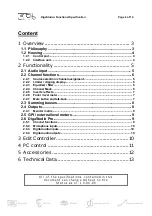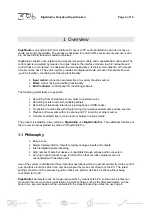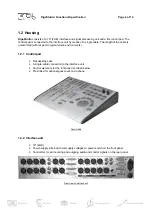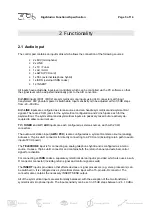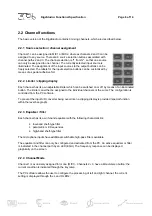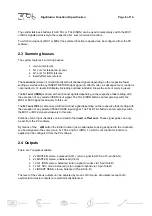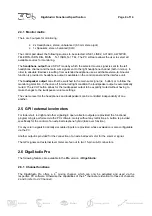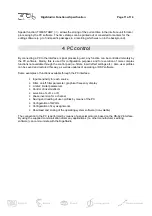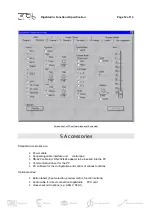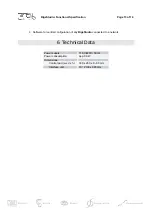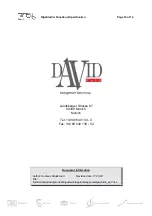
DigaStudio: Functional Specification
Page 8 of 14
The central talk-back buttons (TALK TEL or TALK ISDN) can be used to temporarily switch the MIC1
or MIC2 signals exclusively to the respective N-1 sum (command function).
To which microphone (MIC1 or MIC2) the selected function is applied can be configured from the PC
software.
2.3 Summing busses
The system features 4 summing busses:
•
main sum (stereo)
•
N-1 sum for telephone (mono)
•
N-1 sum for ISDN (stereo)
•
Insert/effect sum (stereo)
The
main sum
(stereo) is mixed directly with all channel signals depending on the respective fader
setting as well as with any INSERT RETURN input signal (in effect mode); a subsequent sum control is
not provided. A 14-level LED display (including overload indicator) shows the current summing level.
The
N-1 sum (ISDN)
is mixed with all channel signals depending on the respective fader setting with
the exception of any selected ISDN input signal. The TALK ISDN button can temporarily switch the
MIC1 or MIC2 signal exclusively to this sum.
The
N-1 sum (TEL)
is also mixed with all channel signal depending on the respective fader setting with
the exception of any selected TELEPHONE input signal. The TALK TEL button can temporarily switch
the MIC1 or MIC2 signal exclusively to this sum.
Portions of all 3 input channels can be mixed to the
insert / effect sum
. These signal gains can only
be set from the PC software.
By means of the
LIM
button the limiter function (as an alternative to being assigned to the channels)
can be assigned to the sums (main, N-1 TEL and N-1 ISDN). To which sum the limiter function is
applied can be configured from the PC software.
2.4 Outputs
There are 7 outputs available:
•
2 x MASTER, stereo, balanced (XLR + return signal to AWS via 15-pin Sub-D)
•
2 x MASTER, stereo, unbalanced (Cinch)
•
1 x N-1 ISDN, stereo, balanced (return signal to codec via 15-pin Sub-D)
•
1 x N-1 TEL, mono, balanced (return signal to hybrid via 15-pin Sub-D)
•
1 x INSERT SEND, stereo, balanced (15-pin Sub-D)
The level of the various outputs can be adjusted by means of trim pots. All outputs (except both
asymmetrical master outputs) are electronically balanced.
Summary of Contents for DigaStudio
Page 1: ...DigaStudio DigAS...


